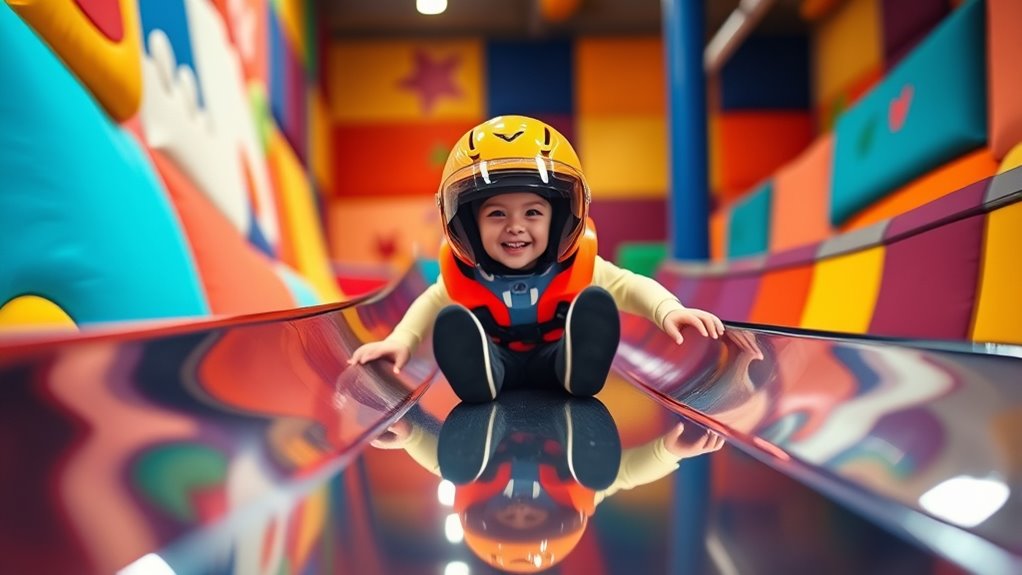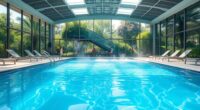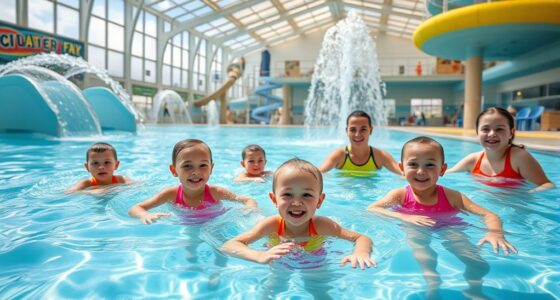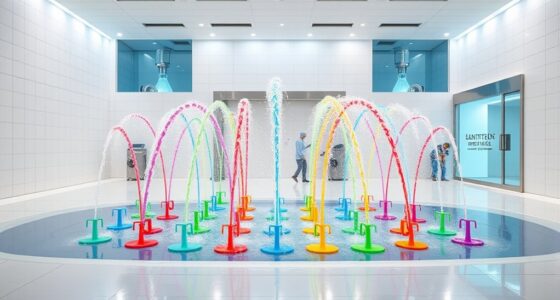Most indoor parks don’t allow GoPros or similar cameras on slides, mainly for safety reasons. Devices are often banned if they’re loose or extendable, and mounts like selfie sticks are usually forbidden on rides. If you want to capture memories safely, you should follow park rules and use proper straps or mounted accessories in designated areas. Want to know how to film safely and legally? Keep exploring for more tips.
Key Takeaways
- GoPros may be permitted on slides if securely mounted and device restrictions are followed; check individual park policies.
- Loosely held or handheld cameras are typically prohibited during rides to prevent safety hazards.
- Mounting devices like chest or head straps are preferred; selfie sticks and extendable mounts are usually banned.
- Staff may restrict or deny GoPro use on slides for safety, especially if devices are unsecured or pose a risk.
- Always review park signage and obtain staff approval before attempting to film or mount a camera on slides.
General Policies for GoPros at Indoor Parks

Most indoor parks allow you to bring GoPros as personal belongings, but you need to follow specific rules to guarantee safety and compliance. Generally, GoPros are permitted, but they must not be mounted or used in restricted ways. Some parks require you to use body straps, like chest or wrist mounts, instead of handheld devices to prevent obstruction or hazards. Tripods, selfie sticks, and monopods are usually banned to avoid safety risks and interference. Commercial filming needs explicit park approval, and casual visitors can’t use professional equipment without permission. Park staff have the authority to ask you to remove or store your device if it’s deemed unsafe or disruptive. Always check individual park policies beforehand to ensure you’re following their specific rules for GoPro use. Additionally, many parks have designated areas or specific ride policies regarding filming, so reviewing these guidelines can help prevent issues during your visit. It’s also advisable to be aware of privacy concerns and respect other visitors’ experiences to maintain a positive environment.
Safety Concerns and Restrictions on Rides

Safety concerns and restrictions on rides considerably influence how and when you can use your GoPro at indoor parks. Many parks prohibit loose articles, including cameras, to prevent objects from becoming projectiles or causing distractions during rides. Some parks allow secured devices, like GoPros mounted with chest or wrist straps, but policies vary widely. Safety remains the top priority to protect guests from potential hazards. Additionally, certain rides restrict filming altogether, such as those with intense movements or confined spaces. Parks like Disney permit GoPros on most rides but restrict specific attractions. Mounting options are limited to secure mounts like chest or wrist straps, while extendable selfie sticks and tripods are generally banned. These restrictions aim to balance guest safety with the desire to capture ride memories. It is also important to consider ride safety protocols and adhere to park-specific rules to ensure a safe and enjoyable experience.
Personal Use vs. Commercial Photography Rules
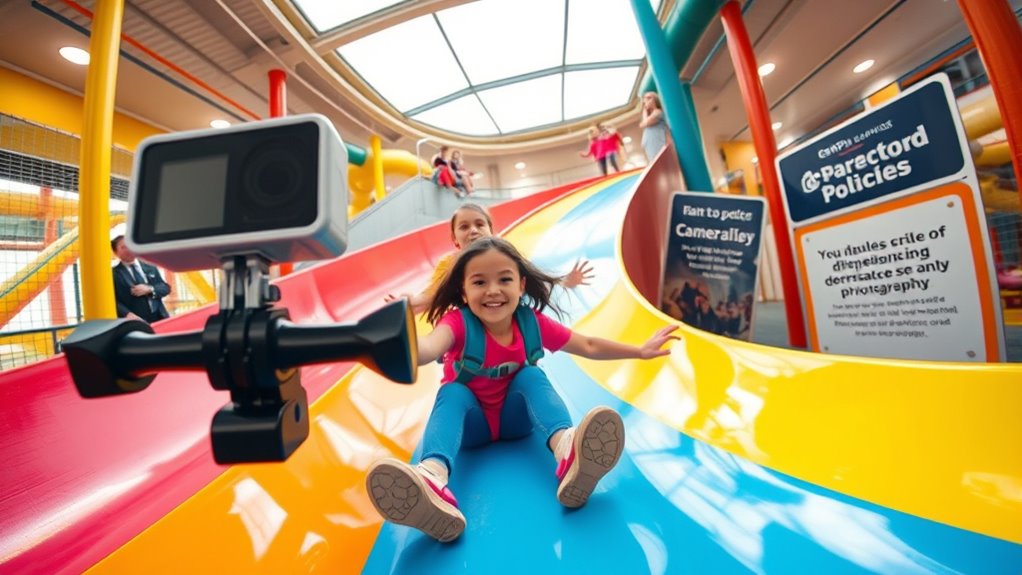
When it comes to taking photos at parks, personal use is usually allowed, but you need permission for commercial shoots. Rules about what equipment you can use and where you can shoot often differ between parks. Make sure you understand these restrictions before capturing images to avoid trouble. Recent policies have become more restrictive, especially following the merger of major park companies, and some parks may enforce nationwide bans on filming and photography to enhance safety and reduce liability. Additionally, photography regulations vary widely and should be reviewed beforehand to prevent violations.
Personal Use Permitted
Personal photography with a GoPro is generally permitted in indoor parks for capturing your own family moments and experiences. You can use handheld devices like cameras and cell phones freely, but tripods often need park approval. Remember, artificial lighting or props are usually prohibited indoors. To guarantee everyone’s safety and comfort, photography must not interfere with others or block public spaces. Additionally, choosing the correct projector type can significantly enhance your home cinema experience.
Commercial Permission Necessary
While indoor parks generally allow personal photography without permits, engaging in commercial photography requires additional authorization. Commercial shoots often need permits if you use specialized equipment or if the activity impacts the environment. Here are key points to contemplate:
- You’ll need a permit if you’re using tripods, generators, or other gear.
- Locations may have specific rules, requiring permission for commercial use.
- Fees and application processes vary, often needing advance planning.
- Some spaces restrict commercial photography entirely or limit access.
- Permits are typically required if shooting impacts traffic, pedestrians, or alters the space’s intended use.
- It’s important to understand and adhere to indoor park regulations to avoid penalties and ensure a smooth experience.
Understanding these rules helps you avoid legal issues and ensures smooth permission acquisition. Always check with the park’s management or relevant authorities before planning any commercial shoot to confirm requirements. This proactive approach saves time and prevents potential disruptions.
Usage Restrictions Vary
Usage restrictions for photography and videography at indoor amusement parks differ considerably depending on whether you’re capturing images for personal enjoyment or commercial purposes. For personal use, most parks allow casual photos and videos with devices like GoPros and smartphones, unless posted rules say otherwise. However, restrictions may apply on rides or slides for safety reasons. Sharing images on social media is usually permitted, but selling or commercial distribution isn’t allowed without explicit permission. Commercial filming requires permits, fees, and prior approval, with strict rules on equipment and final product approval. Equipment like tripods and professional gear often need special permits. Always check signage and staff guidance before recording, as parks reserve the right to revoke permission at any time to guarantee safety, privacy, and smooth operations. Additionally, understanding state-specific tax laws can influence your overall planning if you are involved in commercial filming activities.
Specific Park Regulations and Variations
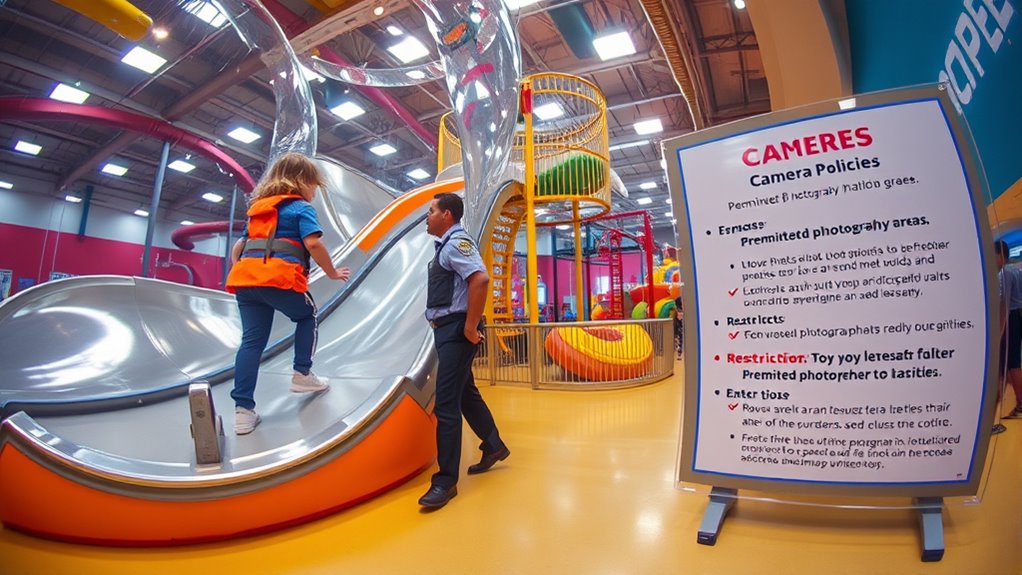
Park regulations regarding camera use, including GoPros on slides, vary considerably depending on the location. You need to be aware that policies differ based on several factors: 1. Public versus private areas—cameras are allowed in public zones but restricted in private spaces like restrooms. 2. State and local laws—these influence whether audio recording or incidental footage is permitted. 3. Privacy expectations—placing cameras where personal privacy is anticipated is generally prohibited. 4. Park-specific signage—some parks may post signs clarifying camera rules, helping you understand what’s allowed. Always check the park’s posted policies before filming. While personal use is usually permitted, certain areas or activities may have restrictions to ensure safety and privacy. Additionally, surveillance camera regulations can vary depending on jurisdiction, so it’s wise to verify local laws beforehand. Understanding privacy policies also helps prevent unintended violations.
Securing Your Camera: Mounts and Attachments
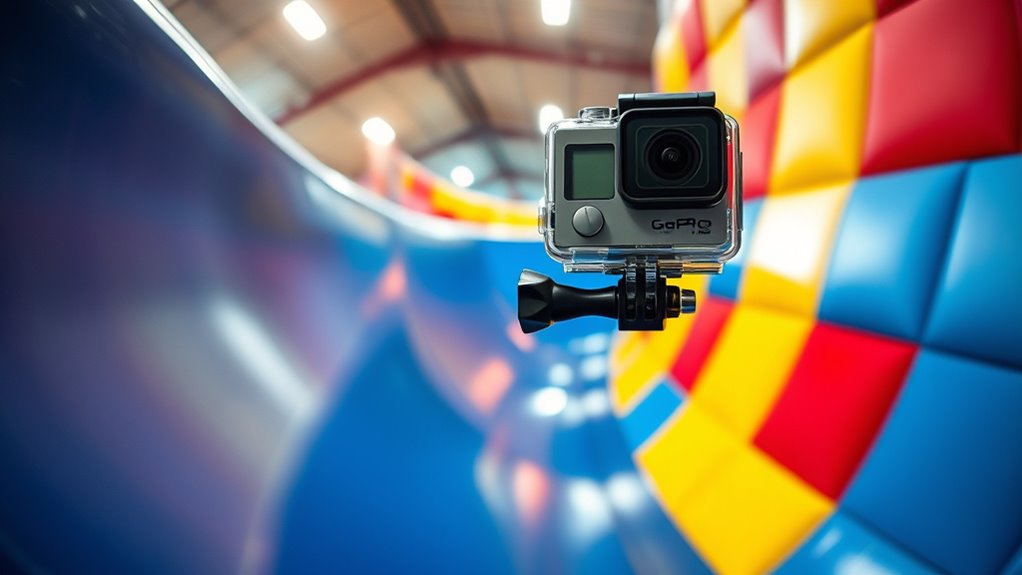
To keep your GoPro secure on a slide, you need to focus on proper mounting techniques and use approved attachment devices. Always double-check your hardware and make safety checks before starting to make sure everything stays in place. Taking these steps helps prevent accidents and captures smooth, reliable footage. The GoPro Mounting System is designed for durability and ease of use in various environments, ensuring your camera remains stable during active use. Additionally, reviewing amusement park camera policies can help prevent any issues during your visit.
Proper Mounting Techniques
Securing your GoPro effectively starts with selecting the right mount for your activity and making certain it fits your camera model. To do this, follow these steps:
- Choose a mount designed for your specific surface (helmet, curved, flat).
- Confirm the mount is compatible with your GoPro model.
- Use quick-release buckles, making sure they click securely before use.
- Regularly check all screws, bolts, and adhesive bonds for tightness and stability.
- Proper mounting also involves adjusting pivot arms and extensions for the best angle, and balancing the camera during setup. Before starting, test the setup on a stable surface, and perform safety checks to prevent detachment or movement during activity. Ensuring secure attachment reduces risk and ensures clear footage.
Approved Attachment Devices
Choosing the right attachment device is essential for guaranteeing your GoPro stays secure during your activities. Metal mounts are durable and affordable, compatible with tripods and selfie sticks, making them versatile options. The GoPro magnetic swivel clip can attach to metal surfaces for unique angles, but it’s not suited for high-speed activities. For hands-free filming, chest and head strap mounts are reliable, with adjustable straps for comfort and stability. The GoPro Pet Mount is designed for dogs, offering back and chest options, though footage may be shaky. For adventure and underwater activities, specialized mounts like the flexible tripod or underwater mounts provide stability and protection. Always select mounts suited to your activity and environment to prevent accidents and ensure secure footage. Properly securing your camera with suitable mounts can also help prevent loss or damage during intense activities. Additionally, choosing mounts with rust-resistant materials can be beneficial for outdoor or humid environments.
Safety Checks Before Use
Before you hit the slide, it’s essential to perform safety checks to guarantee your camera stays secure throughout the ride. First, verify that your camera is designed for high-impact environments, preventing damage or malfunction. Next, make certain your mounting system is secure to avoid losing the camera mid-ride. Third, check that the slide material supports your chosen attachment method without slipping or damaging the surface. Additionally, consider the camera’s durability to ensure it can withstand the vibrations and shocks during the ride. Finally, confirm that the combined weight of the camera and mount doesn’t exceed safety limits, avoiding detachment or instability. By following these steps, you minimize risks, keep your footage safe, and guarantee a fun, worry-free experience. Properly securing your camera is critical for capturing your ride without compromising safety or equipment integrity. Security measures are essential to prevent accidents and protect your equipment during high-adventure activities.
Restrictions on Camera Equipment and Accessories
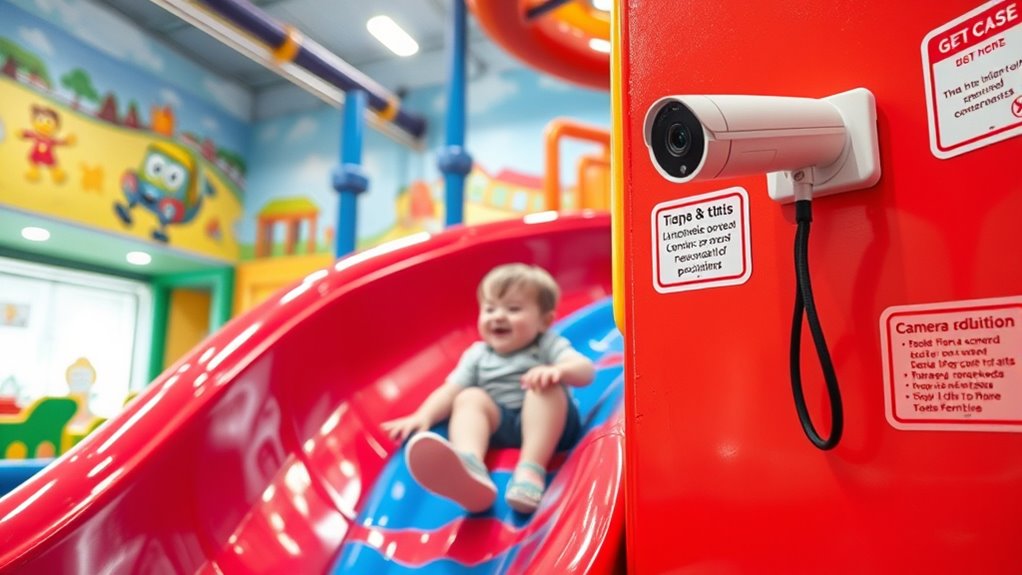
When visiting venues with slides or attractions, there are often specific restrictions on camera equipment and accessories to guarantee safety and a smooth experience. Most venues allow personal cameras, but professional gear usually needs permission. Lens sizes are sometimes limited; for example, MLB stadiums restrict lenses to certain sizes like 4.5 or 8 inches. Tripods and monopods are generally banned in public areas because they can block views or create hazards. Camera bags might be restricted or inspected at entry, and items like selfie sticks or drones are often prohibited. Commercial photography typically requires prior approval, and equipment should never obstruct pathways or other guests’ views. Always check individual venue policies before visiting, as rules can vary and may change over time. Security protocols at many venues include equipment checks to ensure safety for all attendees. Additionally, understanding market trends and insights can help visitors stay informed about the latest regulations and safety measures affecting camera use.
Indoor Park Policies on Photography During Rides
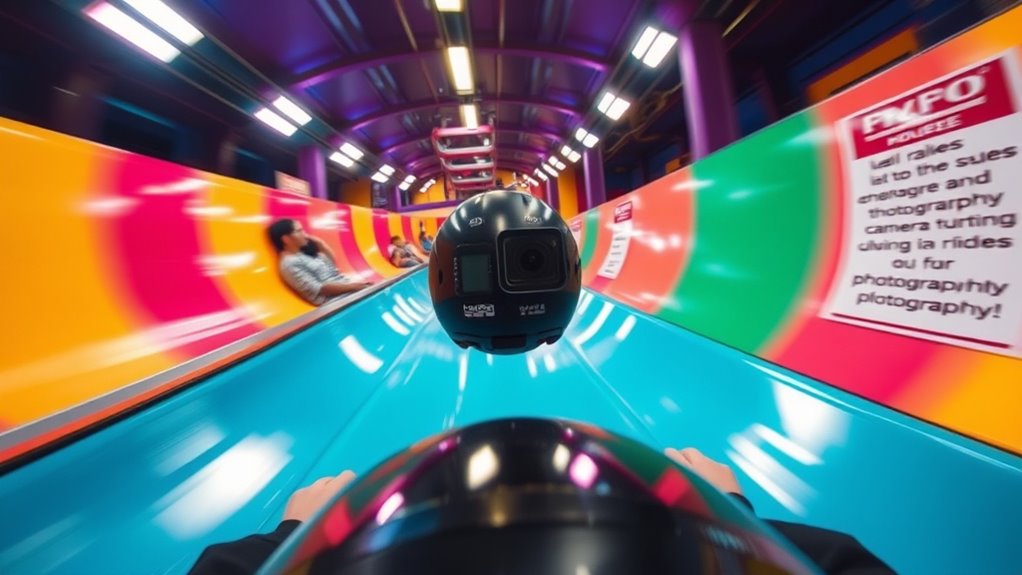
Indoor park policies on photography during rides prioritize safety and guest experience. To prevent accidents, parks typically ban loose or unsecured cameras, including GoPros, during rides. They often require:
Indoor park policies ban loose cameras like GoPros during rides for safety and guest experience.
- Cameras to be securely mounted with multi-point harnesses that won’t detach.
- On-ride cameras to be pre-approved by staff.
- Use of selfie sticks or extendable mounts on rides to be forbidden.
- Flash and additional lighting to be prohibited, especially in dark or indoor rides.
These rules help prevent injuries caused by flying objects or equipment interference with safety restraints. Parks also monitor camera equipment to guarantee it doesn’t compromise safety or ride operation. Furthermore, parks commonly perform visual inspections to ensure compliance before rides operate. Proper camera safety measures are essential to maintain a secure environment. Following these policies ensures a safe, enjoyable experience for everyone.
Park Discretion and Enforcement of Camera Rules

Park management often exercises discretion in enforcing camera rules on slides and other attractions, balancing safety concerns with guest enjoyment. Staff have authority to decide when cameras violate safety or disrupt operations, which varies by park policy and staff judgment. Some parks prohibit action cameras outright due to liability risks, while others permit them with tethering or specific mounts. Enforcement may involve verbal warnings, confiscation, or guest removal if rules are broken or safety is threatened. Visibility of policies through signage, signage, or briefings influences compliance, but ultimately, on-site staff make final judgments. They use tools like radios, incident reports, and security measures to monitor adherence. This flexible approach aims to keep guests safe while allowing for some level of camera use, depending on the situation. Additionally, understanding electric dirt bike horsepower can help in assessing the safety features of various camera setups, especially when capturing high-speed or off-road activities.
Best Practices for Capturing Memories Safely
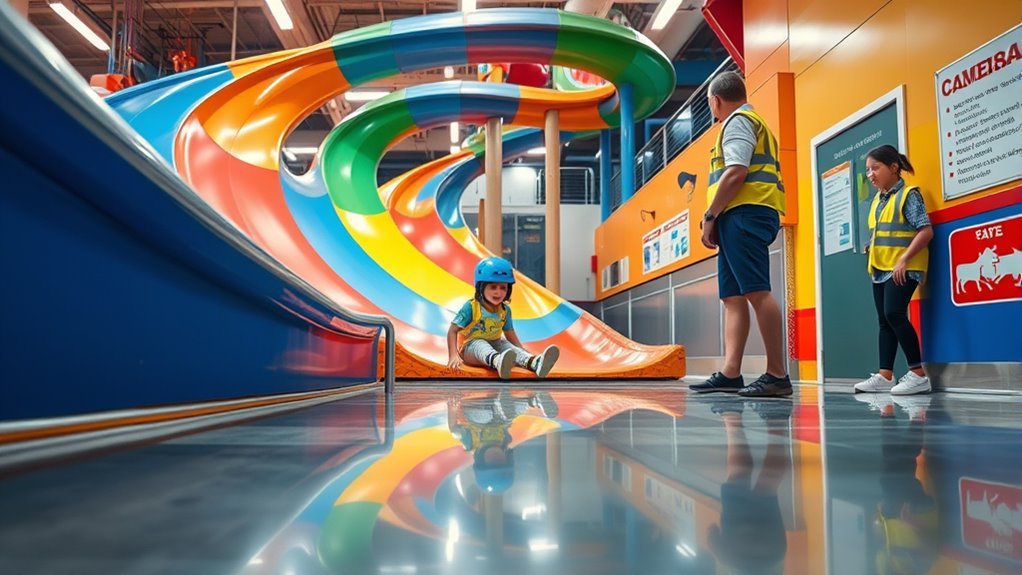
Capturing your memories safely requires careful planning and awareness of best practices to prevent accidents or privacy issues. To do this effectively, it’s important to understand the security camera placement laws that govern filming in different areas. Proper soundscapes and audio quality can also enhance the overall experience, so consider these elements when choosing your equipment. 1. Camera Placement: Position cameras where they won’t obstruct views or create blind spots, ensuring everyone’s safety. 2. Lighting Conditions: Use good lighting—natural or artificial—to improve video clarity and detail. 3. Privacy Considerations: Respect privacy laws by avoiding private areas and obtaining consent when needed. 4. Equipment Selection: Choose cameras suited for indoor use, like those with wide-angle lenses for broad coverage. Regularly inspect and maintain your equipment, and be mindful of privacy and safety regulations. Following these steps helps you capture memories without compromising safety or privacy.
Frequently Asked Questions
Can I Use a Gopro to Record Rides Without Permission?
You can’t use a GoPro to record rides without permission. Parks typically require secure mounting and explicit approval from staff to guarantee safety and comply with policies. Using a handheld or unsecured camera risks injury, violations can lead to removal, and you might face fines or bans. Always check the park’s specific rules beforehand, and seek permission if you want to use your GoPro during rides to avoid issues.
Are There Age Restrictions for Bringing Cameras Into Indoor Parks?
You might face age restrictions for bringing cameras into indoor parks, depending on the specific rules of the venue. While there’s no universal law, parks often restrict minors from carrying certain devices, especially on rides or slides, for safety reasons. You should check posted signage or ask staff directly to confirm if there are age-related limitations. Always supervise minors using cameras and follow staff instructions to avoid issues.
Do All Indoor Parks Have the Same Gopro Policies?
No, all indoor parks don’t have the same GoPro policies. You’ll find some parks allow them if they’re securely mounted and you get management’s approval, while others ban cameras altogether for safety reasons. Policies vary widely depending on the park’s safety concerns, copyright protections, and ride types. Always check with the park beforehand or look for posted rules to avoid surprises and make sure you follow their specific guidelines.
Is It Possible to Rent Cameras Instead of Bringing My Own?
While renting cameras at indoor parks isn’t common, some parks might offer disposable cameras or standard point-and-shoot rentals, but not GoPros or action cameras. You’d need to check with the specific park beforehand, as most don’t provide rental options for high-action devices. It’s usually more reliable to bring your own GoPro with secure mounts and waterproof housing, ensuring you follow staff instructions to avoid equipment confiscation or ride restrictions.
What Are the Penalties for Violating Camera Rules?
If you violate camera rules, you could face fines, legal action, or removal from the property. You might also be sued for invasion of privacy, especially if you record in private areas. In some cases, criminal charges could apply if laws are egregiously broken. Additionally, your reputation and trust within the community may suffer. To avoid these penalties, always follow the specific rules and obtain necessary permissions.
Conclusion
So, next time you’re tempted to sneak your GoPro onto a slide, remember: indoor parks love a good camera ban as much as they love perfecting their safety drills. Want epic footage? Stick to the rules, or risk becoming the park’s next viral “what not to do” meme. After all, capturing memories shouldn’t come at the cost of safety—or a lifetime ban. Play it smart, film responsibly, and keep the fun rolling!

